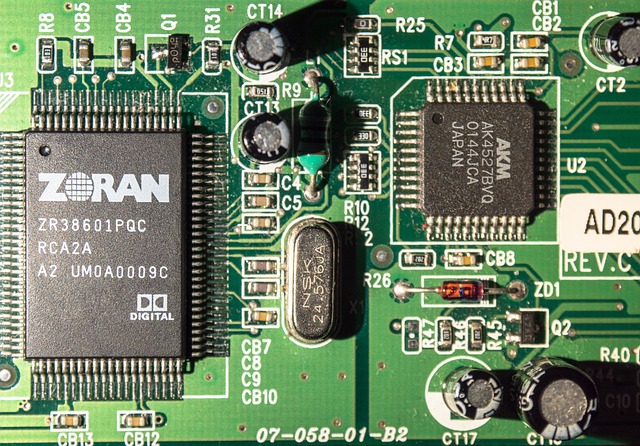Generative AI empowers chatbots in e-commerce to enhance customer interactions through personalized content creation and interactive dialogues, boosting sales opportunities. Strategic planning is vital, defining the chatbot's role (24/7 support or guided purchases) and aligning it with product value propositions to build trust and loyalty. Tool selection involves robust NLP and ML platforms like Dialogflow or IBM Watson for contextually appropriate responses. Development starts with defining conversational flows, fine-tuning language models on e-commerce data, and testing for accuracy. Successful integration into e-commerce platforms requires seamless functionality across site navigation and processes, with continuous improvement based on user feedback and AI trends.
“Unleash the power of Generative AI to transform your e-commerce with a dynamic chatbot. This comprehensive guide navigates you through the process of creating an intelligent, conversational partner that enhances customer engagement and sales. From understanding the fundamentals of Generative AI and its integration with chatbots, to defining your bot’s purpose, choosing the right tools, developing, testing, and continuously improving, we cover all aspects. Discover how AI chatbots for e-commerce can revolutionize your online store.”
- Understanding Generative AI and Chatbots
- Planning and Defining Your Ecommerce Chatbot's Purpose
- Choosing the Right Tools and Technologies
- Developing and Training the Chatbot
- Integration, Testing, and Continuous Improvement
Understanding Generative AI and Chatbots

Generative AI refers to a powerful class of artificial intelligence models that can create novel content, from text and images to music and videos. These systems learn patterns in vast datasets and use them to generate new, original outputs. In the context of e-commerce, ai chatbots for ecommerce leverage generative AI to enhance customer interactions and drive sales. They can craft personalized product descriptions, generate creative marketing copy, or even design tailored shopping experiences based on individual user preferences.
Chatbots, driven by natural language processing (NLP), facilitate human-computer conversations. When combined with generative AI capabilities, they become dynamic agents that can engage in interactive dialogues with customers. For instance, a chatbot could ask users about their preferences and then use this information to propose relevant products or offer tailored recommendations, significantly improving the user experience and increasing sales opportunities in e-commerce settings.
Planning and Defining Your Ecommerce Chatbot's Purpose

When creating an AI chatbot for e-commerce, defining its purpose is the first step in ensuring its success. Before you begin coding or integrating any technology, clearly outline what role your chatbot will play in enhancing user experiences and driving sales. Will it be a 24/7 customer service representative, providing instant support and answering product queries? Or perhaps it’s designed to guide users through their purchase journey, offering personalized product recommendations based on browsing history and past purchases?
This planning stage involves understanding your target audience, their needs, and the unique value propositions of your products or services. By defining these parameters, you can tailor your chatbot’s conversational abilities, ensuring it offers relevant and engaging interactions that foster trust and loyalty among users. This strategic approach sets the foundation for a robust AI chatbot that effectively contributes to your e-commerce business’s bottom line.
Choosing the Right Tools and Technologies

Creating an AI chatbot for e-commerce involves selecting the right tools and technologies from the outset. Key considerations include choosing a robust platform that supports natural language processing (NLP) and machine learning (ML) capabilities, as these are essential for understanding user queries and generating contextually relevant responses. Popular options include platforms like Dialogflow or IBM Watson, which offer pre-built models and customization tools to tailor the chatbot’s behavior to specific sales and customer service scenarios.
Additionally, integrating with existing e-commerce systems is crucial for a seamless experience. Look for tools that can easily connect with your online store, inventory management software, and CRM systems to access real-time data and provide accurate, product-focused assistance. This integration ensures that the chatbot can offer personalized recommendations, answer stock or pricing queries, and guide users through the checkout process efficiently, enhancing the overall customer experience in an AI-driven shopping environment.
Developing and Training the Chatbot

Developing and training an AI chatbot for e-commerce involves a meticulous process. It begins with defining the chatbot’s purpose, such as customer support, product recommendations, or order assistance. This step is crucial as it determines the conversational flows and responses the chatbot will generate. Once the scope is established, developers choose an appropriate language model, fine-tuning it on vast datasets relevant to e-commerce. This training process teaches the chatbot to understand user queries, extract essential information, and generate contextually relevant replies.
During training, diverse customer interactions are fed into the model, enabling it to learn a wide range of potential questions and scenarios. Advanced techniques like transfer learning and reinforcement learning can enhance the chatbot’s performance by refining its responses over time. Regular testing and evaluation ensure the chatbot provides accurate and helpful outputs, adapting to the dynamic nature of e-commerce conversations.
Integration, Testing, and Continuous Improvement

After developing your AI chatbot, the next crucial steps are integration, testing, and continuous improvement. Integrate the chatbot seamlessly into your e-commerce platform to ensure a smooth user experience. This involves aligning the chatbot’s functionality with your site’s navigation, product pages, shopping cart, and checkout processes. A well-integrated AI chatbot can guide users through their purchasing journey, answering queries and providing recommendations in real time.
Testing is vital to guarantee the chatbot’s accuracy and reliability. Conduct thorough tests across various scenarios—from common customer inquiries to edge cases. Use a diverse dataset representative of your target audience to assess the chatbot’s performance. Continuous improvement involves regularly updating and refining the chatbot based on user feedback, analytics, and emerging trends in AI technology. By iteratively enhancing the chatbot’s capabilities, you can ensure it remains effective in supporting customers and driving sales in the competitive e-commerce landscape.
Creating a generative AI chatbot for your ecommerce platform is a strategic move that can enhance customer engagement and drive sales. By understanding the core concepts of generative AI and chatbots, planning their purpose, selecting suitable tools, and implementing continuous improvement through testing, you can develop an effective AI chatbot that revolutionizes the way your business interacts with customers. Integrating these advanced technologies into your ecommerce landscape opens up new possibilities for personalized shopping experiences, ultimately fostering customer satisfaction and loyalty.
